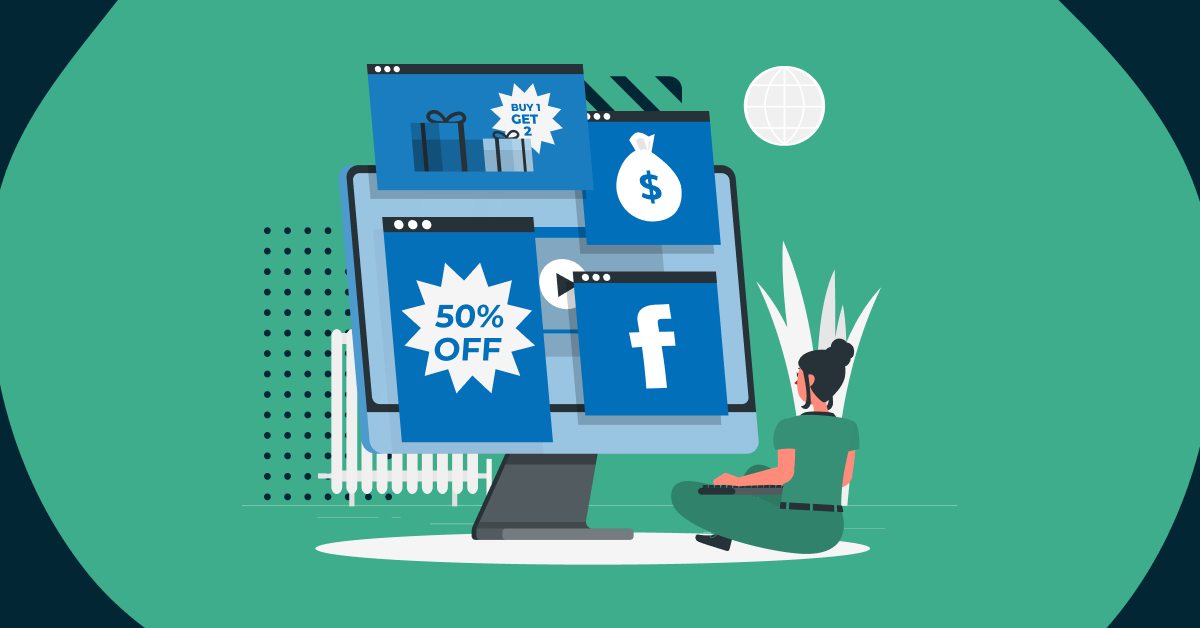So how do you create an engaging Facebook ad design?
You log on to your Facebook profile and scroll for exciting content. While you are scrolling and enjoying the content on your feed, you come across an ad. The images in the ad are blurry, ad copy is vague, and you are unable to fathom what the company is trying to sell. Facebook is the perfect platform to run ads. It has an estimated audience of 1.39 billion active users. Running ads on Facebook to target your prospects and ideal buyers is an intelligent approach to drive the audience to your social profile or landing page.
However, it’s not simple to get started with a Facebook ad design. Marketers and brands have to consider many things. They often feel stumped when the time to design and launch a new ad is near.
Ad design is crucial to the brands. It is like a visual communication with the audience; thus, it should be attractive, engaging, and compels the audience to take action. Despite having a good product and exceptional prices, many ad campaigns fail because of poor, bland, or unappealing ad design.
A great Facebook ad design has the following features:
-Grabs your audience’s attention
-Introduces your brand and informs the audience about the offered products or services.
-Directs the audience about their next step.
In today’s article, we will share eight experts Facebook ad design secrets to help you pull off a successful Facebook ad campaign and boost your conversions.
The secrets mentioned below are equally helpful for beginners and the mavens. These secrets will ensure that you do not waste your hard-earned money on Facebook ads that the audience scrolls past and fails to drive the desired action from them.
Without further ado, let’s start to unveil those secrets!
1. Consider Your Ad Format In The Design Process
 The first secret to high converting Facebook ads is deciding which ad format to use. Facebook is generous enough to provide eight primary ad formats along with some other variations. These formats and options help the marketer design and run ads according to their marketing objectives and goals.
The first secret to high converting Facebook ads is deciding which ad format to use. Facebook is generous enough to provide eight primary ad formats along with some other variations. These formats and options help the marketer design and run ads according to their marketing objectives and goals.The following are some of the commonly used ad formats:
a) Photo
It is the most basic and common ad format. It includes an image and ad copy.
b) Video
Marketers can display a whole video to showcase their brand, products, or services.
c) Stories
Ads run in this format are not shown on the user’s feed; instead, they are displayed when the user is viewing the stories of different people. Ads showcased in this format are displayed in full-screen to capture the undivided attention of the audience.
d) Carousel
It is helpful for businesses who want to display multiple products in a single ad. Each image has its link to its respective landing page.
e) Slideshow
This ad format is the middle ground between video ads and basic photo ads. Marketers can run a slideshow of multiple pictures combined with a soundtrack.
Be very mindful while selecting the ad format. Make sure it aligns with your marketing goals and drives the maximum audience to your landing page.
2. Choose The Best Ad Placement For Your Objective
Facebook ads’ placement is equally important as its format. Placement of ads gives marketers insight into the amount of space he has to display the ad and helps him develop a creative and attention-grabbing design.
For selecting the best ad placement according to your marketing goals, you must be familiar with your options.
The following list contains the familiar places for displaying the ad. We have also mentioned the tips to help you use it strategically for your marketing goals.
a) Desktop News Feed
This ad placement is best for increasing engagement, generating sales, and leads. This placement allows longer ad copy and descriptions.
b) Desktop Right Column
This ad format works well for running retargeting ads. It is inexpensive, displays smaller images and font size of ad copy.
c) Mobile Newsfeed
It offers concise ad copy and a shorter link description. This ad placement increases engagement and reach.
d) In-Stream Video
This placement of the ad is similar to YouTube ads. The Facebook ad will be played before or during a video.
e) Stories
More than 500 million people watch Facebook stories. They provide a full-screen experience of ads to users. The ads uploaded on a story can be 15 seconds longer.
Choose the correct ad placement depending upon your marketing goal. For instance, if you want to remind your existing customers about yourself, you can use desktop right column placement for retargeting them.
3. Have A Clear Value Proposition And Call-To-Action
How long do you take to read a post on your social media newsfeed?
Probably a few seconds, right?
Well, you are not alone here. Mobile users have a short attention span. They do not spend more than 1.7 seconds browsing, viewing, or reading a post on their newsfeeds.
Hence, marketers have less than 2 seconds to convey their message to the audience and direct them about their next move. For this purpose, make sure that you provide them with a clear value proposition and CTA.
Use catchy pictures that stand out from the visually chaotic newsfeed of your users. Keep your ad copy short, clear, and compelling.
Your CTAs should also align with the purpose of the ad. Failure to use the correct CTA will render your ad campaign futile. For instance, using the CTA of Download on the advertisement of hotel reservations will confuse the audience, and they won’t take the desired action.
4. Keep The Landing Page Consistent With Your Ad
When your users click your Facebook ad to reach your landing page, make sure that it is in accordance with your FB ad. If the ad and landing page don’t look interrelated, visitors will abandon the landing page.
The landing page and ad should share common elements, such as font size and style, colors, placement of pictures. The similarities in the landing page and ad help the user feel connected and give him familiarity. If the ad and landing page have nothing in common, the user will not feel comfortable staying on the landing page. In addition, brands and marketers should ensure to place similar CTAs on the ad and landing page.
Thus, always use the design elements on your ad in accordance with your web pages.
5. Get Your Images Right
Your images represent your brand on Facebook; thus, it is crucial to select the right images that are attractive, evoke emotions, and resonate with your brand. Try to use unique images and not from free sources. If a user sees a stock image used in a Facebook ad, the brand will appear less professional and credible to him.
Hence, display the images captured or designed by you to represent your brand, and keep the audience hooked to your ad.
Apart from selecting an attractive picture, marketers must ensure that the images and videos are correct in size and ratio according to chosen format and ad placement. Poorly formatted photos and videos make them appear grainy and pixelated.
6. Consider Color Psychology
 Depending upon your niche and the products you want to sell, be highly considerate about the colors you add to your ad design.
Depending upon your niche and the products you want to sell, be highly considerate about the colors you add to your ad design.Your selected colors should resonate with your brand voice. For instance, if your brand sells apparel for senior citizens, using neon and bright tones of the color will not align with your brand. Similarly, a business selling baby items shouldn’t use dark and gloomy colors like grey, brown, black, etc.
Remember, do not go overboard with colors. Stick to 2-3 primary colors to design your ad. Adding numerous colors make the ad look visually displeasing.
7. Design For Mobile
Do you especially switch on your laptop to log onto Facebook?
99% of internet users access social networking sites through their mobile phones.
It means that your ads should be designed for mobile devices; instead of desktop devices. One of the easiest ways to make your ads engaging for mobile devices is to make the videos and ads vertical.
Moreover, marketers can also benefit from the latest 360-degree vertical ad. This ad format drives impressive results, especially when the marketers want the audience to engage with the ad. Users can move their mobile phone screens to view the entire image and learn more about the brand.
8. Combat Ad Fatigue
Would you pay attention to a picture or video that you have viewed numerous times? Of course not. People get easily bored if they are shown the same thing repeatedly. Your Facebook ads are no exception. If a person has seen your ad multiple times, he won’t notice the next time, let alone click on it. Therefore, to make your ads work effectively, combat ad fatigue and give them new touches to make them appear fresh and new for the targeted audience.
Hey, don’t worry, pals!
You don’t have to design ads from scratch. Here’s what you do to combat ad fatigue:
-Change your imagery frequently into the basic ad template to avoid the monotony in the ad.
-Another easy tip to give a fresh look to your ad campaign is to change the background image of the ad. For example, if you have displayed your product on a gray background, switch it to white background.
-Flip the picture horizontally to change the placement of the objects on your image.
In A Nutshell
Facebook ads are one of the greatest gifts bestowed upon marketers to promote their brand, attract the audience, and boost conversions.
Facebook ads are not about selecting the template and deciding on a budget. Many other factors, such as images, ad copies, CTAs, etc., determine your ads’ success.
With the help of the secrets revealed above, you can pull off a unique and captivating ad campaign to achieve your marketing goals.
What factors do you consider when designing Facebook ads? We would love to hear your tips and tricks in the comments below.


